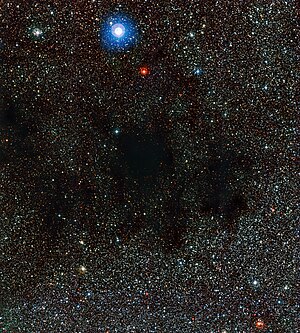
Crux is a constellation of the southern sky that is centred on four bright stars in a cross-shaped asterism commonly known as the Southern Cross. It lies on the southern end of the Milky Way's visible band. The name Crux is Latin for cross. Even though it is the smallest of all 88 modern constellations, Crux is among the most easily distinguished as its four main stars each have an apparent visual magnitude brighter than +2.8. It has attained a high level of cultural significance in many Southern Hemisphere states and nations.

Carina is a constellation in the southern sky. Its name is Latin for the keel of a ship, and it was the southern foundation of the larger constellation of Argo Navis until it was divided into three pieces, the other two being Puppis, and Vela.

Cygnus is a northern constellation on the plane of the Milky Way, deriving its name from the Latinized Greek word for swan. Cygnus is one of the most recognizable constellations of the northern summer and autumn, and it features a prominent asterism known as the Northern Cross. Cygnus was among the 48 constellations listed by the 2nd century astronomer Ptolemy, and it remains one of the 88 modern constellations.

Corona Australis is a constellation in the Southern Celestial Hemisphere. Its Latin name means "southern crown", and it is the southern counterpart of Corona Borealis, the northern crown. It is one of the 48 constellations listed by the 2nd-century astronomer Ptolemy, and it remains one of the 88 modern constellations. The Ancient Greeks saw Corona Australis as a wreath rather than a crown and associated it with Sagittarius or Centaurus. Other cultures have likened the pattern to a turtle, ostrich nest, a tent, or even a hut belonging to a rock hyrax.

Dorado is a constellation in the Southern Sky. It was named in the late 16th century and is now one of the 88 modern constellations. Its name refers to the mahi-mahi, which is known as dorado ("golden") in Spanish, although it has also been depicted as a swordfish. Dorado contains most of the Large Magellanic Cloud, the remainder being in the constellation Mensa. The South Ecliptic pole also lies within this constellation.
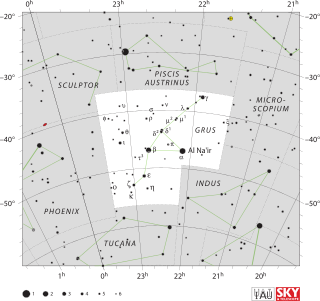
Grus is a constellation in the southern sky. Its name is Latin for the crane, a type of bird. It is one of twelve constellations conceived by Petrus Plancius from the observations of Pieter Dirkszoon Keyser and Frederick de Houtman. Grus first appeared on a 35-centimetre-diameter (14-inch) celestial globe published in 1598 in Amsterdam by Plancius and Jodocus Hondius and was depicted in Johann Bayer's star atlas Uranometria of 1603. French explorer and astronomer Nicolas-Louis de Lacaille gave Bayer designations to its stars in 1756, some of which had been previously considered part of the neighbouring constellation Piscis Austrinus. The constellations Grus, Pavo, Phoenix and Tucana are collectively known as the "Southern Birds".
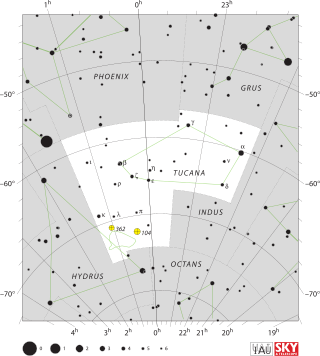
Tucana is a constellation of stars in the southern sky, named after the toucan, a South American bird. It is one of twelve constellations conceived in the late sixteenth century by Petrus Plancius from the observations of Pieter Dirkszoon Keyser and Frederick de Houtman. Tucana first appeared on a 35-centimetre-diameter (14 in) celestial globe published in 1598 in Amsterdam by Plancius and Jodocus Hondius and was depicted in Johann Bayer's star atlas Uranometria of 1603. French explorer and astronomer Nicolas Louis de Lacaille gave its stars Bayer designations in 1756. The constellations Tucana, Grus, Phoenix and Pavo are collectively known as the "Southern Birds".
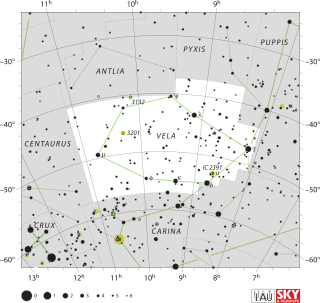
Vela is a constellation in the southern sky, which contains the Vela Supercluster. Its name is Latin for the sails of a ship, and it was originally part of a larger constellation, the ship Argo Navis, which was later divided into three parts, the others being Carina and Puppis. With an apparent magnitude of 1.8, its brightest star is the hot blue multiple star Gamma Velorum, one component of which is the closest and brightest Wolf-Rayet star in the sky. Delta and Kappa Velorum, together with Epsilon and Iota Carinae, form the asterism known as the False Cross. 1.95-magnitude Delta is actually a triple or quintuple star system.

The Large Magellanic Cloud (LMC) is a dwarf galaxy and satellite galaxy of the Milky Way. At a distance of around 50 kiloparsecs (163,000 light-years), the LMC is the second- or third-closest galaxy to the Milky Way, after the Sagittarius Dwarf Spheroidal (c. 16 kiloparsecs (52,000 light-years) away) and the possible dwarf irregular galaxy called the Canis Major Overdensity. Based on the D25 isophote at the B-band (445 nm wavelength of light), the Large Magellanic Cloud is about 9.86 kiloparsecs (32,200 light-years) across. It is roughly one-hundredth the mass of the Milky Way and is the fourth-largest galaxy in the Local Group, after the Andromeda Galaxy (M31), the Milky Way, and the Triangulum Galaxy (M33).
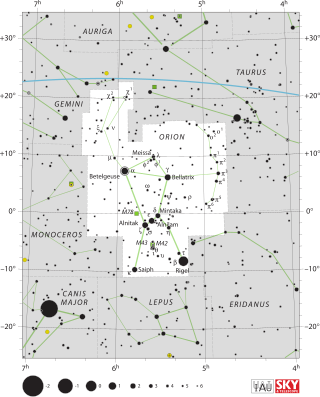
Orion is a prominent set of stars visible during winter in the northern celestial hemisphere. It is one of the 88 modern constellations; it was among the 48 constellations listed by the 2nd-century astronomer Ptolemy. It is named for a hunter in Greek mythology.
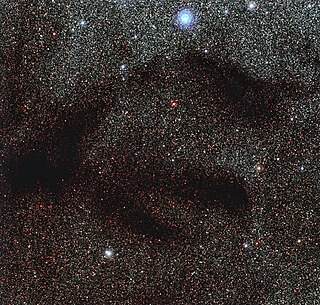
A dark nebula or absorption nebula is a type of interstellar cloud, particularly molecular clouds, that is so dense that it obscures the visible wavelengths of light from objects behind it, such as background stars and emission or reflection nebulae. The extinction of the light is caused by interstellar dust grains in the coldest, densest parts of molecular clouds. Clusters and large complexes of dark nebulae are associated with Giant Molecular Clouds. Isolated small dark nebulae are called Bok globules. Like other interstellar dust or material, the things it obscures are visible only using radio waves in radio astronomy or infrared in infrared astronomy.

Perseus is a constellation in the northern sky, named after the Greek mythological hero Perseus. It is one of the 48 ancient constellations listed by the 2nd-century astronomer Ptolemy, and among the 88 modern constellations defined by the International Astronomical Union (IAU). It is located near several other constellations named after ancient Greek legends surrounding Perseus, including Andromeda to the west and Cassiopeia to the north. Perseus is also bordered by Aries and Taurus to the south, Auriga to the east, Camelopardalis to the north, and Triangulum to the west. Some star atlases during the early 19th century also depicted Perseus holding the disembodied head of Medusa, whose asterism was named together as Perseus et Caput Medusae; however, this never came into popular usage.

Circinus is a small, faint constellation in the southern sky, first defined in 1756 by the French astronomer Nicolas-Louis de Lacaille. Its name is Latin for compass, referring to the drafting tool used for drawing circles. Its brightest star is Alpha Circini, with an apparent magnitude of 3.19. Slightly variable, it is the brightest rapidly oscillating Ap star in the night sky. AX Circini is a Cepheid variable visible with the unaided eye, and BX Circini is a faint star thought to have been formed from the merger of two white dwarfs. Two sun-like stars have planetary systems: HD 134060 has two small planets, and HD 129445 has a Jupiter-like planet. Supernova SN 185 appeared in Circinus in 185 AD and was recorded by Chinese observers. Two novae have been observed more recently, in the 20th century.

Musca is a small constellation in the deep southern sky. It was one of 12 constellations created by Petrus Plancius from the observations of Pieter Dirkszoon Keyser and Frederick de Houtman, and it first appeared on a celestial globe 35 cm (14 in) in diameter published in 1597 in Amsterdam by Plancius and Jodocus Hondius. The first depiction of this constellation in a celestial atlas was in Johann Bayer's Uranometria of 1603. It was also known as Apis for 200 years. Musca remains below the horizon for most Northern Hemisphere observers.

The Lagoon Nebula is a giant interstellar cloud in the constellation Sagittarius. It is classified as an emission nebula and has an H II region.

Sanduleak -69 202 was a magnitude 12 blue supergiant star, located on the outskirts of the Tarantula Nebula in the Large Magellanic Cloud. It is notable as the progenitor of supernova 1987A.
Australian Aboriginal astronomy has been passed down orally, through ceremonies, and in their artwork of many kinds. The astronomical systems passed down thus show a depth of understanding of the movement of celestial objects which allowed them to use them as a practical means for creating calendars and for navigating across the continent and waters of Australia. There is a diversity of astronomical traditions in Australia, each with its own particular expression of cosmology. However, there appear to be common themes and systems between the groups. Due to the long history of Australian Aboriginal astronomy, the Aboriginal peoples have been described as "world's first astronomers" on several occasions.

DL Crucis is a variable star in the constellation Crux.
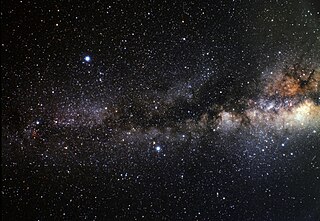
In astronomy, the Great Rift is a dark band caused by interstellar clouds of cosmic dust that significantly obscure (extinguish) the center and most radial sectors of the Milky Way galaxy from Earth's perspective.
Indigenous astronomy is the name given to the use and study of astronomical subjects and their movements by indigenous groups. This field encompasses culture, traditional knowledge, and astronomy. Astronomy has been practised by indigenous groups to create astronomical calendars which inform on weather, navigation, migration, agriculture, and ecology. Alongside calendric uses, constellations have names and stories that inform ceremony and social structures holding specific and deep cultural meanings for respective indigenous groups.
